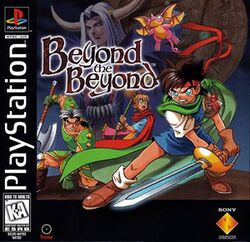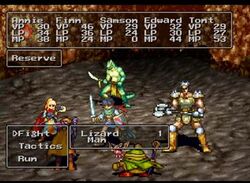Software:Beyond the Beyond
| Beyond the Beyond | |
|---|---|
 | |
| Developer(s) | Camelot Software Planning |
| Publisher(s) | Sony Computer Entertainment |
| Director(s) | Shugo Takahashi |
| Producer(s) | Shugo Takahashi |
| Programmer(s) | Kenji Numaya Masashi Muramori Makoto Yamamoto |
| Artist(s) | Ami Shibata |
| Writer(s) | Shugo Takahashi |
| Composer(s) | Motoi Sakuraba |
| Platform(s) | PlayStation |
| Release | |
| Genre(s) | Role-playing |
| Mode(s) | Single-player |
Beyond the Beyond, known in Japan as Beyond the Beyond: Harukanaru Kanān e (ビヨンド ザ ビヨンド ~遥かなるカナーンへ~, lit. "Beyond the Beyond: To Far Away Kanaan"), is a role-playing video game that was developed by Camelot Software Planning and published by Sony Computer Entertainment for the PlayStation in 1995. Though not the first role-playing game released for the PlayStation, Beyond the Beyond was the first RPG available in the west for the console using a traditional Japanese RPG gameplay style like Final Fantasy, Dragon Quest and Phantasy Star.[2] The characters were designed by popular manga artist Ami Shibata.[3]
Gameplay
Gameplay in Beyond the Beyond is, for the most part, standard for a role-playing video game. However, the turn-based battle system does contain one feature that was not standard in role-playing games at the time.[4] Dubbed the "Active Playing System", this feature allows the player to increase the chances of either landing an improved attack on an enemy or defending from an enemy attack by pressing the X button at the correct time during battle. It is similar to the timing-based attacks in the later role-playing game Final Fantasy VIII (1999).[4]
Plot
Long ago in the world of Beyond the Beyond, a battle raged between the 'Beings of Light' and the 'Warlocks of the Underworld'. Before the planet was destroyed, the two sides signed a treaty leaving the surface world to the Beings of Light and underground to the Warlocks. After hundreds of years of peace, inexplicable happenings begin to occur. The player must control Finn, a young swordsman, to stop the evil power that has broken the treaty and invaded the surface world.[5]
Development
The soundtrack was composed by Motoi Sakuraba, who later worked on other Camelot Soft titles such as Shining Force III and the Golden Sun series along with other series such as Star Ocean and Valkyrie Profile.
For the North American release, Beyond the Beyond was translated into English by four production personnel at Sony Computer Entertainment America.[6]
Reception
| Reception | ||||||||||||||||||||||
|---|---|---|---|---|---|---|---|---|---|---|---|---|---|---|---|---|---|---|---|---|---|---|
| ||||||||||||||||||||||
Critical assessments of Beyond the Beyond were divided upon its release: While Shawn Smith and Sushi-X of Electronic Gaming Monthly found it to be an impressive RPG,[8] Dan Hsu and Crispin Boyer in the same publication and Glenn Rubenstein in GameSpot deemed it derivative and underwhelming, though still a solid and satisfying enough experience for fans of the genre,[8][2] GamePro's Scary Larry considered it outright "lame and predictable",[13] and Next Generation described it as "painfully derivative, plodding, and not even a terribly challenging adventure".[12] However, there were points of agreement, with even the most positive reviews remarking that the game has a very generic RPG visual style[8][10][2][12] and simply does not look like a next generation RPG,[8][10][2][11][12][13] though some also remarked that the 3D battle graphics are impressive.[8][10][12]
Most reviews said that the story is highly derivative and suffers from overlong, dull dialogues,[8][10][2][11] though Next Generation, which otherwise gave one of the more negative reviews, said the story was pleasingly long and interesting.[12] While Shawn Smith and Dan Hsu praised the music,[8] Glenn Rubenstein, Scary Larry, and IGN all called it tepid and generic, and criticized that it is in MIDI format instead of the high quality Red Book audio that was by this time standard for CD games.[2][13][11] Another common criticism was that the battles are excessively frequent.[11][12][13]
The game maintains a 44% average rating on GameRankings, from 8 reviews. Review scores for the game included a 6 out of 10 from Electric Playground.[7] In a retrospective review, Andrew Long of RPGamer argued that the extensive time it takes to complete the game is due mostly to long and complex dungeons, frequent random encounters, and the steep difficulty of bosses.[14]
References
- ↑ "Sony PlayStation Available Software sorted by Release Date @ www.vidgames.com". 1998-06-11. https://web.archive.org/web/19980611181118/http://www.vidgames.com/ps/software/release.html#1995.
- ↑ 2.0 2.1 2.2 2.3 2.4 2.5 2.6 Rubenstein, Glenn. "Beyond the Beyond at GameSpot". GameSpot. http://www.gamespot.com/reviews/beyond-the-beyond-review/1900-2546773/. Retrieved 2015-06-17.
- ↑ "Beyond the Beyond". Electronic Gaming Monthly (Ziff Davis) (72): 82. July 1995.
- ↑ 4.0 4.1 Nickel, Thomas (Summer 2011), Parish, Jeremy, ed., "Beyond the Beyond: Beyond Redemption?", GameSpite Quarterly (8), http://www.gamespite.net/toastywiki/index.php/Games/G8-BeyondTheBeyond, retrieved 12 September 2011
- ↑ Beyond the Beyond Instruction Booklet, pg.4-5
- ↑ "Finalizing the Fantasy". Electronic Gaming Monthly (Ziff Davis) (94): 91. May 1997.
- ↑ 7.0 7.1 "Beyond the Beyond for PlayStation". GameRankings. https://www.gamerankings.com/ps/196754-beyond-the-beyond/index.html.
- ↑ 8.0 8.1 8.2 8.3 8.4 8.5 8.6 8.7 "Review Crew: Beyond the Beyond". Electronic Gaming Monthly (Ziff Davis) (87): 62. October 1996.
- ↑ Famitsu staff (November 10, 1995). "クロスレビュー" (in Japanese). Famitsu (ASCII) (361). Archived from the original. Error: If you specify
|archiveurl=, you must also specify|archivedate=. https://web.archive.org/web/20220430223812/https://www.famitsu.com/cominy/?m=pc&a=page_h_title&title_id=9004&redirect=no. Retrieved April 30, 2022. - ↑ 10.0 10.1 10.2 10.3 10.4 "Shimmy Shimmy Coco Pop!". October 1996. http://www.gamerevolution.com:80/games/sony/beyobeyo.htm.
- ↑ 11.0 11.1 11.2 11.3 11.4 "Beyond the Beyond". November 21, 1996. http://www.ign.com/articles/1996/11/22/beyond-the-beyond. Retrieved 3 November 2017.
- ↑ 12.0 12.1 12.2 12.3 12.4 12.5 12.6 "Beyond the Beyond". Next Generation (Imagine Media) (23): 266, 268. November 1996.
- ↑ 13.0 13.1 13.2 13.3 "Beyond the Beyond". GamePro (IDG) (97): 110. October 1996.
- ↑ Long, Andrew. "Beyond the Beyond Retroview". RPGamer.com. http://www.rpgamer.com/games/other/psx/btb/reviews/btbstrev1.html. Retrieved 2009-03-13.
External links
 |


